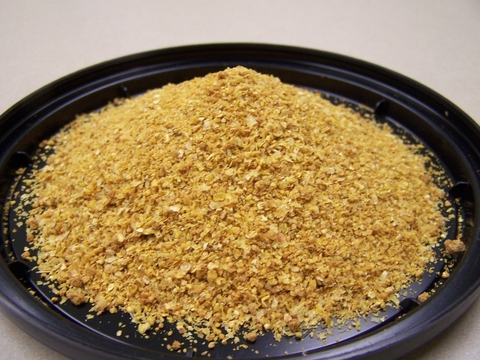Quick facts
Oil content of corn distillers dried grains with solubles (DDGS) doesn’t affect growth performance and carcass traits of grow-finish pigs if the sources have similar metabolizable energy (ME) content. But reducing the oil content of DDGS improves pork fat quality.
The best ME prediction equations developed so far work well when applied to DDGS sources that contain more than six percent oil. But they overestimate ME content of DDGS sources with less than six percent oil.
What is DDGS?
Corn distillers dried grains with solubles (DDGS) is a major co-product of ethanol production. DDGS has been widely used for several years as an important energy and protein source in swine diets. About 35 million metric tons of DDGS are produced yearly in the United States. The swine industry uses more than 12 percent of this amount.
Oil content impacts DDGS value
Most ethanol producers have been removing corn oil before producing DDGS. Thus, traditional high-oil (greater than 10 percent oil) DDGS has been largely replaced by medium-oil (about seven to eight percent oil) DDGS. Some ethanol plants are even producing a low-oil (less than five percent oil) DDGS.
Feeding value and price
For over 15 years the University of Minnesota has studied feeding applications and nutritional value of DDGS for swine. Studies show that removing oil during DDGS production increases changes in energy and nutrient content, and thus the feeding value of DDGS. As a result, there’s a large gap between price and value for DDGS in swine diets.
- Oil and protein content influence DDGS price.
- Metabolizable energy (ME) and digestible amino acid content influence feeding value of DDGS.
University of Minnesota research shows that oil content in DDGS poorly predicts ME content, which adds to the gap between DDGS price and value.
High oil DDGS causes softer pork fat
One of the biggest challenges of using traditional high-oil (greater than 10 percent) DDGS in grow-finish pigs diets is that the corn oil is high in polyunsaturated fatty acids. These fatty acids cause pork fat (especially bellies for bacon) to become softer and more "oily." This can lead to:
- Challenges in further processing of pork products
- A less attractive appearance
- Potentially reduced shelf life
A University of Minnesota study looked at pork fat quality from carcasses of pigs fed DDGS diets with six, 10 and 14 percent oil content. Feeding the six percent and 10 percent oil DDGS diets improved pork fat firmness, including belly fat, compared to carcasses from pigs fed 14 percent oil DDGS. These results suggest that oil extraction in DDGS decreases the negative impact of feeding DDGS on pork fat quality.
Predicting metabolizable energy content of DDGS
University of Minnesota research shows that the most accurate and precise published metabolizable energy (ME) prediction equations are:
Digestible energy = -2,161 + (1.39 × gross energy) - (20.7 × neutral detergent fiber) - (49.3 × ether extract)
ME = -261 + (1.05 × digestible energy) - (7.89 × crude protein) + (2.47 × neutral detergent fiber) - (4.99 × ether extract)
Testing ME predicting equations
The University of Minnesota tested the accuracy of these equations under practical commercial production conditions. Researchers evaluated the effects of feeding DDGS sources differing in oil content (six, 10, or 14 percent oil) to grow-finish pigs.
Pigs fed the six percent oil DDGS diets had slightly reduced gain efficiency. This suggests that the ME prediction equations do a good job estimating ME content of DDGS source with greater than six percent oil. But the equations slightly overestimate ME content of DDGS sources containing less than six percent oil.
Pigs fed diets with different DDGS sources had the same:
- Growth rate
- Average daily feed intake
- Final body weight
Pigs fed diets with different DDGS sources had similar carcass characteristics.
- Hot carcass weight
- Dressing percentage
- Backfat depth
- Loin muscle area
- Percentage of carcass lean
Reviewed in 2018


